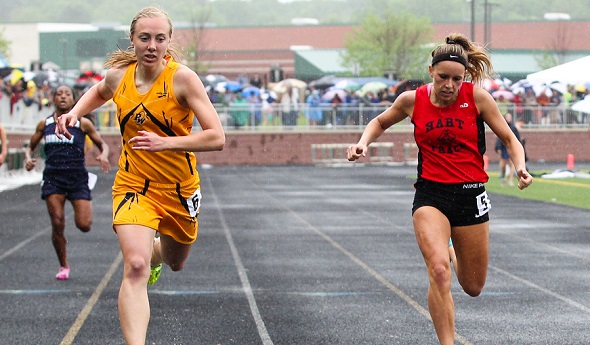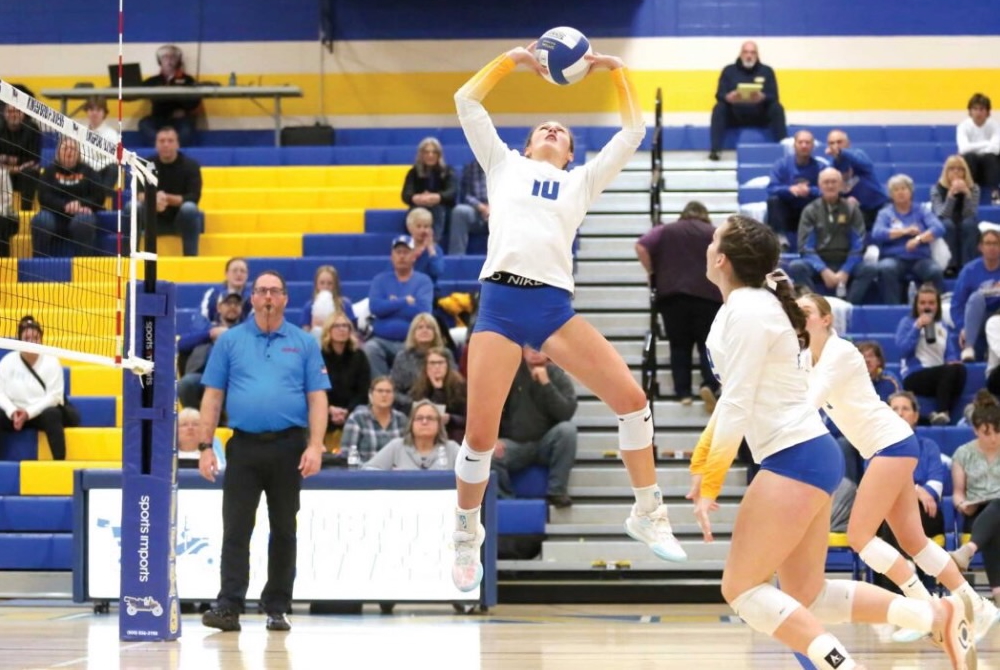
Wirth Shows Worth Again for D3 Power
June 2, 2016
By Dean Holzwarth
Special for Second Half
WESTPHALIA – This past March, fewer than 2 minutes remained in Pewamo-Westphalia's Class C Regional Semifinal basketball loss to Ypsilanti Arbor Prep when junior Brenna Wirth heard a pop in her right ankle.
 She fell to the floor in pain, unaware if her upcoming track and field season would be in jeopardy.
She fell to the floor in pain, unaware if her upcoming track and field season would be in jeopardy.
“That was one of my main concerns when it happened because I didn’t know how bad it was at first,” Wirth said. “It hurt a lot, and I heard a pop when it happened. I think I came down on a girl’s ankle and I was pretty worried.”
Wirth’s anxiety was eased by the good news that awaited her after the game. It turned out to be only a badly sprained ankle. Nothing worse.
“I got lucky I guess,” Wirth said. “But it has motivated me to push myself a little harder to get back to where I want to be.”
Wirth, one of the elite sprinters in Lower Peninsula Division 3, has fully recovered from the injury and is expected to compete in Saturday’s MHSAA Track & Field Finals at Comstock Park High School.
The Pirates have won two MHSAA girls track and field championships over the past three years and will look to go back-to-back Saturday.
Wirth will be an important component in their quest.
“We have a lot of depth, and she is part of that,” P-W track and field coach Scott Werner said. “One of the first pieces we look at is where we can utilize Brenna, and then we build around her to maximize our team points.”
She is thankful the ankle injury didn’t set her back longer than a few weeks.
“It healed a lot faster than I thought it would,” Wirth said. “I slowly began walking on it again, and I went from there. I’m excited for this weekend, and I think our team has a good shot this year again.”
Werner said Wirth has made the necessary strides to make a speedy comeback.
“I consider her healthy now,” he said. “She has been building up and feeling as good as she has the whole year. Things are starting to come together, and we hope we can peak this Saturday and finish things off right.”
Wirth will take part in the 200 and 400, as well as join her teammates as a member of the top-ranked 400 and 800 relay teams.
She won both individual events at last week’s Regional and is considered among the favorites to take home an individual title Saturday.
Wirth has plenty of motivation, especially in the 400, which is her signature event. She placed runner-up at the Finals as a freshman and sophomore.
“I’ve gotten so close in the 400 these past few years, so I’m hoping this is the year,” Wirth said. “I just want to give it my best effort. I’ve worked hard all season to get to this point, so I’m just hoping to run fast for the team. My team is the end goal, everything for them.”
Wirth’s work ethic separates her from other athletes, and it has helped propel her to success on the track and in other sports.
She also competes on the cross country team and delivered a new personal record at the Finals last fall.
“She is just a real athletic kid, and every sport that she is part of she is very good at,” Werner said. “She is such a hard worker, and where she excels at the most the past few years is the 400. That’s a type of race that you have to grind through, and she’s really strong mentally. She can go in and fight through and do her thing.”
Wirth will run Saturday without her older sister, Marissa, by her side. The two shared the track and past two seasons before Marissa graduated.
They drove each other to compete at the highest level.
“We ran on the same relays, and at times I had to run against her,” Wirth said. “It’s a lot different this year, and I really do miss her. She really pushed me, and I think I helped push her a lot. We kept each other going.”
Wirth made her presence known early on in her high school career, emerging as one of the top sprinters on a team chock-full of talented runners.
“She immediately came in and was among our best sprinters of what I would consider a pretty strong sprint program the past few years,” Werner said. “She was an instant-impact-type kid. She has a real positive attitude and sets a really great tone. She’s a good leader, and she’s a part of the strong culture that we have here.”
PHOTO: Pewamo-Westphalia's Brenna Wirth (left) crosses just before Hart's Jennie Gottardo to finish second in the 400 at last season's Lower Peninsula Division 3 Final. (Photo by Jamie Geysbeek/RunMichigan.com.)

Kingsford's Kreider Prepared for Next Level After Finishing Stellar Flivvers Career
By
John Vrancic
Special for MHSAA.com
June 19, 2025
KINGSFORD — After completing a successful high school volleyball career, Maddy Kreider is ready to take the next step.
 The Kingsford senior is taking her talents to Michigan Tech, where she’s expected to continue primarily as a setter.
The Kingsford senior is taking her talents to Michigan Tech, where she’s expected to continue primarily as a setter.
“That will be a big step for sure, but it’ll be exciting being with the girls,” she said. “The girls are taller in college. It will definitely be an adjustment, physically and mentally. We’ll be traveling longer distances, and it’ll be a matter of improving the mental part of my game.”
Kreider was selected the Upper Peninsula’s Defensive Player of the Year her final two seasons after the U.P. Sportswriters and Sportscasters Association began voting for all-U.P. volleyball.
“That’s quite an accomplishment,” she said. “It’s a real honor playing with girls I grew up with. We had a great season.”
The 5-foot-8 setter was a four-year starter and two-year team captain at Kingsford, leading the Flivvers to three Division 2 District titles and back-to-back undefeated Great Northern Conference championships. She twice was named GNC Player of the Year.
She was also selected all-state first team in the fall and all-state second team in 2023, and all-region throughout her prep career. Her serving percentage also topped .900 throughout her four seasons on varsity.
 Last fall, the Flivvers reached the Regional Semifinal at Manistique where they dropped a 3-2 decision to Kingsley.
Last fall, the Flivvers reached the Regional Semifinal at Manistique where they dropped a 3-2 decision to Kingsley.
“I thought we’d get through,” Kreider said. “We came out lights out in the first two sets, then it was close in the last three.”
Also among the team’s highlights this past fall was a victory at Calumet, approximately 2½ weeks after dropping a 3-1 decision to the Copper Kings on Kingsford’s home floor.
“We wanted to play them,” Kreider said. “They’re a great bunch of girls to play against. They’ve been the measuring stick up here for many years. Winning on their floor was super exciting. We knew we had to play well just to be competitive. That was a great confidence builder for our group. We were definitely on a high going into the District.”
The Flivvers opened their postseason with a 3-1 triumph over Houghton, then defeated Escanaba in straight sets in the District Final.
Kreider will join Calumet senior Maddie Torola at MTU this fall. Torola, who recorded a season-high 19 kills in the four-set victory at Kingsford, helped the Copper Kings finish 29-5 and reach the Division 3 Regional Final at Sault Ste. Marie where they dropped a 3-2 decision to Traverse City St. Francis.
“It was fun playing against her in high school,” Kreider said. “It will be even more fun playing as teammates. It’ll be exciting to be playing on the same team.”
Both will be playing under new head coach Cindy Pindral at Tech. Both of Kreider’s parents played for the Huskies, her mother (and Kingsford varsity coach) Jaclynn volleyball from 1998-2002 and her father Jason basketball from 1997-2000.
Maddy Kreider recently earned an additional honor when she was selected Female Athlete of the Year for Kingsford’s Class of 2025. She recently completed a solid track & field season for the Flivvers.
At the U.P. Division 1 Finals, Kreider placed fourth in the 100-meter dash (13.2) and anchored the Flivvers to a third-place finish in the 800 relay (1:51.57) and fourth in the 400 (53.03) on their home track.
Kreider was named one of 32 MHSAA/Farm Bureau Insurance Scholar-Athlete Award winners this winter and plans to study exercise science and kinesiology at MTU.
 John Vrancic has covered high school sports in the Upper Peninsula since joining the Escanaba Daily Press staff in 1985. He is known most prominently across the peninsula for his extensive coverage of cross country and track & field that frequently appears in newspapers from the Wisconsin border to Lake Huron. He received the James Trethewey Award for Distinguished Service in 2015 from the Upper Peninsula Sportswriters and Sportscasters Association.
John Vrancic has covered high school sports in the Upper Peninsula since joining the Escanaba Daily Press staff in 1985. He is known most prominently across the peninsula for his extensive coverage of cross country and track & field that frequently appears in newspapers from the Wisconsin border to Lake Huron. He received the James Trethewey Award for Distinguished Service in 2015 from the Upper Peninsula Sportswriters and Sportscasters Association.
PHOTOS (Top) Kingsford’s Maddy Kreider sets for her teammates during a match last season. (Middle) Kreider, right, takes a photo with Kingsford’s Male Athlete of the Year Gavin Grondin. (Photos provided by the Kingsford athletic department.)

